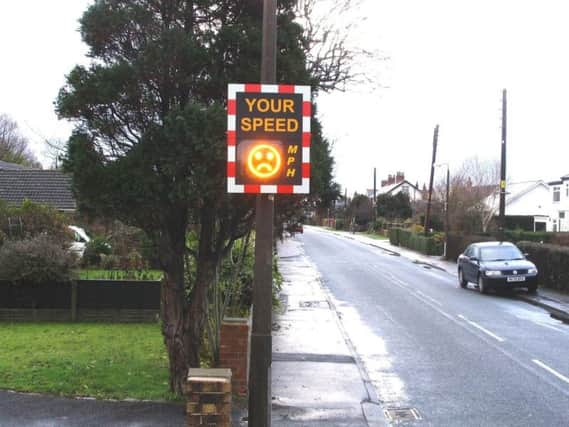'Smiley face' speed camera signs being rolled back in Lancashire, as councils say they are ineffective


The roll-out of Speed Indicator Devices (SPIDS) - electronic signs, which display your speed along with a smiley or frowning face - was acclaimed by road safety campaigners, politicians and residents when first introduced in the county in 2004.
But borough councils have gradually withdrawn from managing them – citing problems with reliability and availability of people putting them up and down – leaving the responsibility largely with Parish Councils, which have no obligation to continue the work.
Advertisement
Hide AdAdvertisement
Hide AdEven Lancashire County Council, which bought Lancashire’s first SPID and co-ordinates their use, admits it does not know which devices are still in use.
Councillor Christine Abram is part of Lea and Cottam Parish Council, which is active in using SPIDS.
She has called on more authorities to do the same, saying: “If they can be used, they should be used.”
Chorley Council has never managed any SPIDs, Preston Council has had “little if no involvement” with the initiative since 2006, and South Ribble stopped managing them in 2017.
Advertisement
Hide AdAdvertisement
Hide AdIn South Ribble, the change mean it is now down to individual parish councils to decided whether they are used, often with neighbouring villages taking a different tack.
In Hutton, the lengthsman has received training on putting the devices up and down.
Parish Council chairman Tom Hastewell, said: “We have decided to use our lengthsman to put them up and down.
“I am responsible for having the SPID in Pope Lane, after fatal accidents there, and I do believe they have an effect. I think the shock of it coming on makes you automatically brake or pay attention to your speed.
Advertisement
Hide AdAdvertisement
Hide Ad“Anything you can do to make drivers aware of their speed is a good thing.”
In Longton, Councillor Graham Gooch, below, chairman of Longton Parish Council, said a decision to stop using SPIDs was brought about by the borough council withdrawing support.
He said: “This caused difficulty because there was no-one to put them up or take them down.”
He added that the devices were “old and unreliable”, and “with inadequate and failing equipment, little evidence of its effectiveness and no means of putting it up or down we decided to stop using it.”
Advertisement
Hide AdAdvertisement
Hide AdLancashire Police first took responsibility for recharging batteries and moving the signs to different stretches of road when six were first bought by Lancashire County Council.
While the force still supports their use, it was decided in 2007 that with growing numbers being installed, it could no longer be responsible for them and instead, LCC has been the main organisation responsible for deploying them for around eight years.
A Lancashire Police spokesperson said: “Speed indictor devices are an effective way of providing immediate driver feedback and reminding motorists of the speed limits on our roads. We fully support their use and believe they can be an effective way of targeting speeding in problem areas.”
Councillor Caroline Moon, right, deputy leader of South Ribble Borough Council, explained the authority was looking at new road safety technology.
Advertisement
Hide AdAdvertisement
Hide AdShe said: “Our existing devices are no longer in good working order and we are looking at options to replace them. We are investigating the technology that is available, as well as what will best meet the needs of our communities in South Ribble.
“Speeding is something that is of concern to everyone at the council and we continue to be committed to working with the police, and our community safety partners, to encourage everyone to drive responsibly throughout the borough.”
Preston Council was active in supporting the initiative, installing plates on lighting columns and purchasing a device via a community grant bid. Since the end of a highways agreement with LCC in 2006, this involvement has stopped.
Councillor Christine Abram of Cottam and Lea, said: “We still believe in SPIDs. Anything that can be used to help stop speeding is a good thing.
“If they can be used, they should be used.
Advertisement
Hide AdAdvertisement
Hide Ad“I don’t believe in mothballing them of there’s nothing wrong with them.
“They are put in places for a reason and my personal belief is that they are effective. They do make you look at your speed.”
Lancashire County Council has 15 SPID devices of its own, which are still in use.
A spokesman for the authority said: “There is evidence that Speed Indicator Devices work in reducing speeds as part of a wider speed management policy involving other education, engagement and enforcement activities carried out by ourselves and other members of the Lancashire Road Safety Partnership.
Advertisement
Hide AdAdvertisement
Hide Ad“They are widely in use across the county, with devices owned by up to 80 Parish Councils and district councils complementing our 15 devices.We coordinate the use of the county council’s SPIDs to address inappropriate speeds across Lancashire, and advise other councils about suitable sites for their SPIDs.”
A spokesman for the Royal Society for the Prevention of Accidents (RoSPA), said: “Speed Indication Devices are widely used across the country acting as a visual reminder to drivers of their speed, they can either show the vehicles actual speed or provide a pictorial message such as a smiley face or an unhappy face when the speed limit is exceeded.
“These are usually used where a lower level of speeding has been identified or in areas of public concern.
“Whilst not as effective as physical traffic calming or speed camera enforcement they are cheaper to deploy and can be effective, especially when moved from location to location.”
Advertisement
Hide AdAdvertisement
Hide AdHe added: “It would be of concern if they are being mothballed to save money. However, if they are not effective in speed reduction then the money saved should be used for other speed management schemes.”